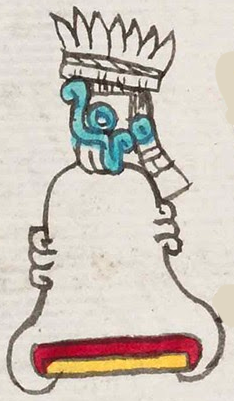Iztactlalocan (Mdz15v)
The mountain (tepetl) that contains the white color (iztac) has rocky (tetl) outcroppings on the right and left, typical of the symbol for a hill or mountain (and, here, a locative). The coloring at the bottom consists of yellow at the opening and red surrounding the yellow. The deity representation atop the mountain is just a head in profile, looking left, largely black and white, but with turquoise coloring in the outer ring of the (double-concentric-circle) eye and in a ring at the back of the head, around the mouth, and up through what may be a long nose reaching toward the headdress. The teeth appear to be two fangs. If this is a person wearing the deity's mask, he has a long ponytail with various wrappings and decorations at the back of his head. The headdress has seven feathers showing and two horizontal bands securing the feathers.
Stephanie Wood
The double-concentric-circle eye fits with what is often called the "goggle eyes" of Tlaloc. Having an elaborate nose and fangs is also known. It is important to remember that the Tlalocs (rain divinities) typically hovered over mountains, like clouds, which would "billow and form thunderheads," as we learn from the Florentine Codex (quoted in the dictionary entry for Tlaloc). The description of the deity in that same source (Book 1, The Gods) says his face was painted black with liquid rubber and spotted with amaranth seeds, neither of which we see here. But it also says that he had a crown of heron feathers, which could be what we see in this depiction. The turquoise color may be a reference to the rain that he would bring.
Gordon Whittaker (2021, 207) notes that this town could have two names, depending upon whether the final "l" should be double or single. "Where the White Tlaloc Is" could be one reading, and the other is "Where There is a Lot of Land."
Stephanie Wood
yztactlalocan. puo
Iztac Tlalocan, pueblo
Stephanie Wood
c. 1541, or by 1553 at the latest
Stephanie Wood
This has a bottom-to-top and down again reading. The iztac (white) is represented in the white mountain, and the Tlaloc (deity) sits on top of the mountain. The representation of the locative -can is inherent (not phonetic) in the symbol of the mountain (tepetl), which often indicates a place.
fuerza divina de la lluvia, tocados, Tlaloc, feathers, plumas, colmillos, color blanco, color turquesa, rojo, amarillo, nombres de lugares

iztac, white, https://nahuatl.wired-humanities.org/content/iztac
Tlaloc, rain deity or priest associated with rain, https://nahuatl.wired-humanities.org/content/Tlaloc
-can (locative suffix), https://nahuatl.wired-humanities.org/content/can-2
Codex Mendoza, folio 15 verso, https://digital.bodleian.ox.ac.uk/objects/2fea788e-2aa2-4f08-b6d9-648c00..., image 41 of 188.
The Bodleian Libraries, University of Oxford, hold the original manuscript, the MS. Arch. Selden. A. 1. This image is published here under the UK Creative Commons, “Attribution-NonCommercial-ShareAlike 3.0 License” (CC-BY-NC-SA 3.0).




